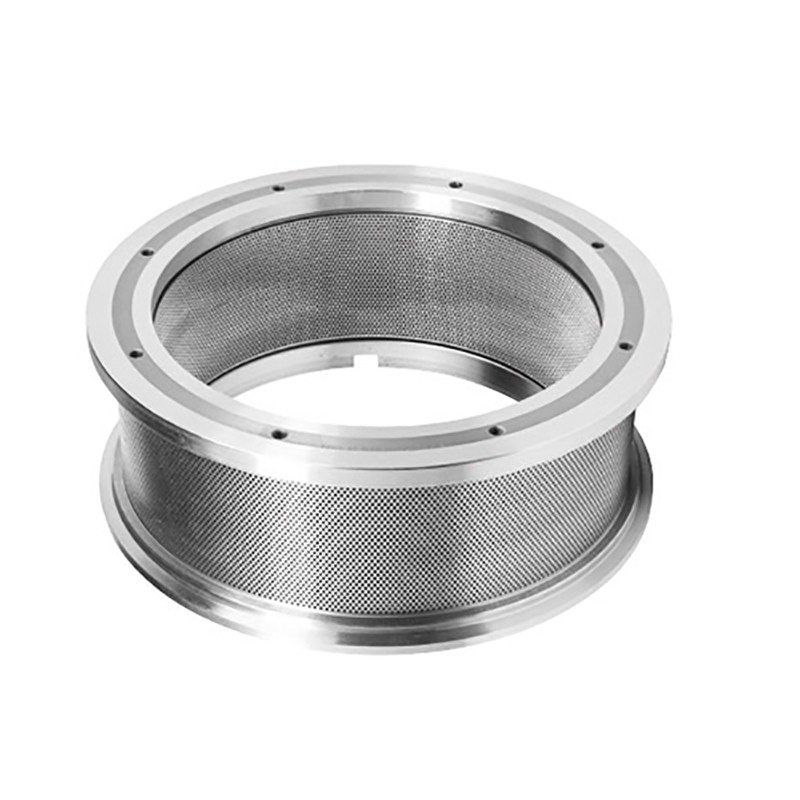Incorrect usage and operation can easily cause cracking of the pellet mill ring die, affecting normal production. Let’s analyze the various causes of ring die cracking and their solutions.
-
Bright Spots on the Clamping Surface and Wear Marks on the Drive Wheel Surface
-
Cause: The clamping block inside the clamping hoop is worn or deformed, causing the ring die to crack.
-
Solution: Replace the clamping hoop promptly.
-
-
Wear on the Drive Wheel Fitting Surface
-
Cause: The fitting surface of the drive wheel is worn, causing a noticeable looseness between the die and the roller, leading to ring die cracking.
-
Solution: Replace or repair the drive wheel promptly, or increase the fitting tolerance of the ring die assembly surface.
-
-
Wear or Deformation of the Compression Ring
-
Cause: The compression ring is worn or deformed, leading to ring die cracking.
-
Solution: Inspect and replace the compression ring promptly.
-
-
Wear of the Drive Key
-
Cause: Wear of the drive key leads to ring die impact and cracking. This is also related to the looseness with the drive wheel. Regularly measure the gap between the key and keyway and replace the drive key promptly.
-
-
Main Shaft Bearing Damage
-
Cause: Damage to the main shaft bearing causes the main shaft to wobble, leading to ring die cracking.
-
Solution: Replace the main shaft bearing promptly.
-
-
Insufficient Elasticity of the Belleville Spring
-
Cause: Insufficient elasticity of the Belleville spring causes the main shaft to wobble, leading to ring die cracking.
-
Solution: Add or replace the Belleville spring.
-
-
Improper Safety Pin or Safety Pin Seat Causing Overload
-
Cause: Use of inappropriate safety pin or safety pin seat causes excessive load, leading to ring die cracking.
-
Solution: Use safety pins provided by the company.
-
-
Ineffective Iron Removal Device
-
Cause: The iron removal device’s performance deteriorates, leading to metal objects causing indentations on the working surface of the ring die, resulting in cracking.
-
Solution: Regularly inspect and clean the iron removal equipment.
-
-
Improper Installation of the Press Roller
-
Cause: The press roller is not properly installed, causing axial misalignment between the press roller and the ring die working area, leading to ring die cracking.
-
Solution: Install the press roller assembly correctly.
-
-
Too Small Gap Between Ring Die and Press Roller
-
Cause: A gap that is too small causes hard contact between the ring die and the press roller, leading to ring die cracking.
-
Solution: Ensure a reasonable gap of 0.1mm to 0.3mm, and use a new press roller with a new die.
-
-
Increased Fiber Material Without a Feeding Scraper
-
Cause: Increased fiber material without a feeding scraper leads to ring die cracking.
-
Solution: Install a new feeding scraper.
-
-
Ring Die Not “Cleaned” When Idle
-
Cause: When the ring die is not used for a period, the holes are not cleaned, causing hardened particles to make it difficult to discharge next time, leading to excessive pressure and cracking.
-
Solution: Immediately fill the die with non-corrosive oily material.
-
-
Using Hard Steel Tools to Install or Remove Ring Die
-
Cause: Directly hammering the ring die with hard steel tools (like an iron hammer) leads to cracking. If force is needed to install the ring die, a wooden hammer should be used.
-
Solution: Use a wooden hammer for installation.
-
-
Excessive Feeding or Changing to Smaller Diameter Die Without Adjusting Feeder
-
Cause: Excessive feeding or failure to adjust the feeder when changing to a smaller diameter die causes unbalanced production and increased load, leading to ring die cracking.
-
Solution: Adjust the feeder motor speed and use a variable frequency controller or electromagnetic controller.
-
-
Wear and Deformation of Press Die Cover
-
Cause: Wear and deformation of the press die cover and loose screws cause tearing at the screw holes on the end face of the ring die.
-
Solution: Replace the press die cover.

-

